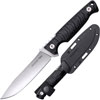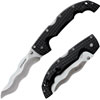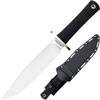|
|
|
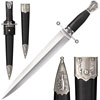 |
|
| Cold Steel Arkansas Toothpick Knife (88GTP) |
Points: 10
|
The main competition to the Bowie knife from the late 1830's to the period just after the Civil War was the Arkansas Toothpick. The Arkansas Toothpick got its namesake as an ironic reference to the coarse, rough and tumble culture that populated the lowlands of Arkansas and the Mississippi delta in the mid 19th century.
|
|
|
|
|
|
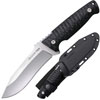 |
|
| Cold Steel Knife Razor Tek 5 (FX-5RZR) |
Points: 3

|
The next step up in the Razor Tek series features a 5 inch recurve blade. A recurve blade gives the benefits of a longer cutting edge and belly at the front. This blade shape offers the benefits of cutting when drawing or pulling the blade through.
|
|
|
|
|
|
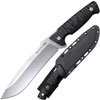 |
|
| Cold Steel Knife Razor Tek 6,5 (FX-65RZR) |
Points: 10

|
The next step up in the Razor Tek series features a 5 inch recurve blade. A recurve blade gives the benefits of a longer cutting edge and belly at the front. This blade shape offers the benefits of cutting when drawing or pulling the blade through.
|
|
|
|
|
|
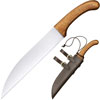 |
|
| Cold Steel Woodsman's Sax (88HUA) |
Points: 3
|
Like some historical saxes that have survived, the Woodsman’s features a stout 11” long blade with the characteristic sloping point and an unadorned wooden handle made from exotic imported hardwood.
|
|
|
|
|
|
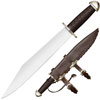 |
|
| Cold Steel Chieftan Sax (88HUK) |
Points: 5
|
Since the Chieftans Sax is meant to be a weapon first and a tool a distant second it comes with a modestly sized brass guard that serves to keep the fingers from sliding forward on to the blade while offering a modicum of protection from opposing weapons.
|
|
|
|
|
|
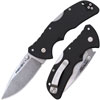 |
|
| Cold Steel Mini Recon 1 Spear Point 10A Stone Wash (27BAS) |
|
The Cold Steel Recon 1 series stands out as a popular collection of knives favored by a diverse range of users including law enforcement officers, military personnel, rescuers, and civilians who prioritize accurate and dependable tools. The reintroduction of the mini model includes an updated handle crafted from injection molded plastic featuring a textured surface that enhances grip even in challenging conditions. The ergonomic design of the handle ensures a seamless fit in the hand, facilitating comfortable and efficient work.
|
|
|
|
|
|
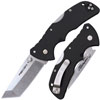 |
|
| Cold Steel Mini Recon 1 Tanto Point 10A Stone Wash (27BAT) |
|
The Cold Steel Recon 1 series stands out as a popular collection of knives favored by a diverse range of users including law enforcement officers, military personnel, rescuers, and civilians who prioritize accurate and dependable tools. The reintroduction of the mini model includes an updated handle crafted from injection molded plastic featuring a textured surface that enhances grip even in challenging conditions. The ergonomic design of the handle ensures a seamless fit in the hand, facilitating comfortable and efficient work.
|
|
|
|
|
|
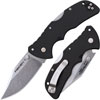 |
|
| Cold Steel Mini Recon 1 Clip Point 10A Stone Wash (27BAC) |
|
The Cold Steel Recon 1 series stands out as a popular collection of knives favored by a diverse range of users including law enforcement officers, military personnel, rescuers, and civilians who prioritize accurate and dependable tools. The reintroduction of the mini model includes an updated handle crafted from injection molded plastic featuring a textured surface that enhances grip even in challenging conditions. The ergonomic design of the handle ensures a seamless fit in the hand, facilitating comfortable and efficient work.
|
|
|
|
|
|
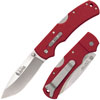 |
|
| Cold Steel Double Safe Hunter Slock Master Folding Knife (23JK) |
|
If you're looking for a budget friendly yet high-performing folding hunter, look no further than the Double Safe Hunter. It's modeled after our extremely popular old-school Voyager®. Its wide, drop-point blade is 3.5" in length and is made of 8Cr13MoV steel, tempered to 57-58 Rockwell hardness.
|
|
|
|
|
|
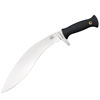 |
|
| Knife Cold Steel Gurkha Kukri Plus (39LMC4) |
Points: 10
|
The Cold Steel Gurkha Kukri was inspired by Cold Steel President, Lynn C. Thompson's close association with Dr. Maung Gyi, chief instructor of the American Bando Association, and a renowned martial artist with wide-ranging knowledge and skills.
Blade made with 3034 stainless steel. Kray-Ex handle. Includes Secure-Ex sheath.
|
|
|
|
|
|
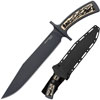 |
|
| Cold Steel Drop Forged 9.5'' Bowie Knife (36MK) |
Points: 5
|
Cold Steel Drop Forged 9.5'' Bowie Knife - addition to our Drop Forged line of knives has total length of 14 inches and features a 9 ½ inch blade, it shares many of the same attributes of the other knives in the series, including the same robust construction, being forged as a single piece of steel, giving it a startling amount of strength.
|
|
|
|
|
|
 |
|
| Cold Steel Recon 1 Spear Point S35VN Knife OD Green (27BSODBK) |

|
Cold Steel Recon 1 Spear Point S35VN knife. Now with an American S35VN Blade Steel Featuring DLC Coating* Our Recon I series continues to set a standard for Tactical Folding Knives that's hard to beat. These tough, dependable knives have been a mainstay in the world of tactical knives for many years, with a hard earned reputation for reliability and strength.
|
|
|
|
|
|
|
|
Tags:
swords, sword, katana, wakizashi, tanto, japanese sword, medieval sword, viking sword, japanese swords, medieval swords, viking swords, knife, knives, saber, armour, movie swords, movie replicas, martial arts, sporting goods, sporting equipment,
|


